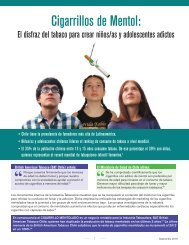Public health successes and missed opportunities
Public-health-successes-and-missed-opportunities-alcohol-mortality-19902014
Public-health-successes-and-missed-opportunities-alcohol-mortality-19902014
Create successful ePaper yourself
Turn your PDF publications into a flip-book with our unique Google optimized e-Paper software.
Burden of alcohol-attributable mortality in the WHO European Region, 1990–2014<br />
Fig. 72. Comparisons of age-st<strong>and</strong>ardized alcohol-attributable mortality for major causes of death, 1990 vs<br />
2014, in the WHO European Region <strong>and</strong> selected subregions<br />
Central-eastern EU 1990<br />
Central-eastern EU 2014<br />
Eastern WHO European Region 1990<br />
Eastern WHO European Region 2014<br />
Central-western EU 1990<br />
Central-western EU 2014<br />
South-eastern WHO European Region 1990<br />
South-eastern WHO European Region 2014<br />
liver cirrhosis<br />
cancer<br />
CVD<br />
unintentional<br />
injury<br />
intentional<br />
injury<br />
Mediterranean 1990<br />
Mediterranean 2014<br />
WHO European Region 1990<br />
WHO European Region 2014<br />
0 200 400 600 800 1000 1200 1400 1600<br />
Rate per million<br />
In terms of composition of causes of alcohol-attributable death (see Fig. 72), as indicated before, mortality rates due to<br />
cancer seem to be relatively stable. This is not surprising, given the considerable <strong>and</strong> varying lag time of two decades,<br />
especially of cancer sites where acetaldehyde plays a key role (165–168). While alcohol consumption plays an important<br />
part in cancer mortality, any change in alcohol consumption <strong>and</strong> thus also the potential effects of alcohol policy measures,<br />
will be evident in the long term, as could be seen from the major short-term policy changes such as the Gorbachev-era<br />
anti-alcohol campaign, which had no effect on cancer rates (169,170).<br />
Mortality due to liver cirrhosis moves predictably <strong>and</strong> almost instantly with changes in consumption (90), <strong>and</strong> is a good<br />
indicator of harmful drinking in a society (171,172) <strong>and</strong> thus is relevant for policy (156). However, if liver cirrhosis is to be<br />
used for monitoring harm or alcohol use, the impact of hepatitis B <strong>and</strong> C infections have to be taken into account as well<br />
(173), <strong>and</strong> the indicator should reflect the net impact of alcohol.<br />
The main drivers of marked changes in the burden of alcohol-attributable mortality in the WHO European Region are CVD<br />
<strong>and</strong> injuries. As for cardiovascular mortality, alcohol consumption has no marked impact as long as drinking is maintained<br />
at moderate levels. The beneficial effects on ischaemic diseases (104,174), described earlier, are almost negated by<br />
the detrimental effects on all other CVD (96). As a result, in 2014, the proportion of alcohol-attributable cardiovascular<br />
mortality was less than 5% of all alcohol-attributable mortality for the central-western part of the EU, about 12% for<br />
the Mediterranean countries, <strong>and</strong> 14% for the central-eastern part of the EU (for the EU as a whole, it was 10%). This<br />
cause-of-death category comprised 54% of all alcohol-attributable mortality in the eastern WHO European Region, <strong>and</strong><br />
36% in the WHO European Region as a whole. Cultures with both episodic <strong>and</strong> chronic heavy drinking will experience<br />
mainly detrimental effects, which are obviously most pronounced when very heavy binges are the dominant pattern of<br />
drinking for a large part of the population such as in the eastern WHO European Region during the observation period. (For<br />
individual large-scale studies, see (5,54,175,176); for discussion, see (110,177); for supporting aggregate-level studies,<br />
see (178–181).)<br />
Morbidity <strong>and</strong> mortality rates due to injury have been decreasing globally, including in the European Region (158). The<br />
speed of this decline may be halted <strong>and</strong> even reversed by alcohol consumption (see Fig. 72 <strong>and</strong> below; for a historical<br />
comparison of alcohol poisoning deaths in the Russian Federation, see (182)). It needs to be mentioned that mortality<br />
due to alcohol-attributable unintentional injury (i.e. alcohol poisoning) may be underestimated in countries with a high<br />
prevalence of heavy binge drinking (e.g. the Russian Federation (183–185); Estonia (186,187)). (For a discussion, see<br />
(188,189).)<br />
51




